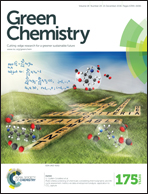Isobutylene-rich imidazolium ionomers for use in two-phase partitioning bioreactors†
Abstract
Imidazolium ionomer derivatives of an isobutylene-rich elastomer demonstrated superior absorption characteristics for target molecules of biological interest compared to their non-ionic parent material, while retaining biocompatibility with a range of suspended cell cultures. Halide displacement from brominated poly(isobutylene-co-paramethyl styrene) was used to introduce 0.23 mmol per g-polymer of imidazolium bromide functionality to the polymer, resulting in up to 10-fold improvements in n-octanol and n-butanol partition coefficients (PCs) and up to 4-fold improvements in selectivity (α). In contrast to analogous imidazolium ionic liquids (ILs) that were cytotoxic toward Saccharomyces cerevisiae, Clostridium acetobutylicum and Pseudomonas putida, the ionomers had no effect on suspended cell growth. In addition, these ionomers demonstrated surface antimicrobial activity towards select microorganisms under static conditions with direct surface/microbe contact. Thus, these materials do not affect suspended cell growth while simultaneously reducing cell proliferation at the ionomer interface.


 Please wait while we load your content...
Please wait while we load your content...